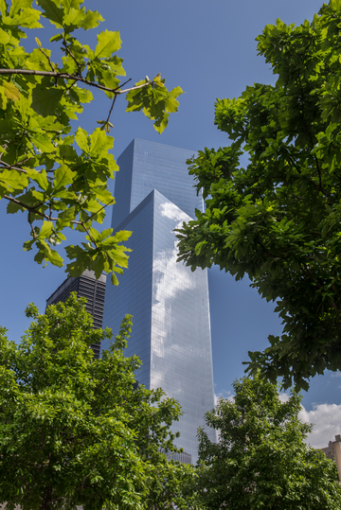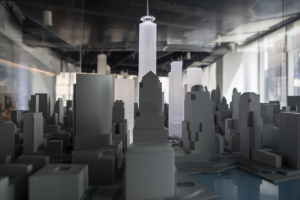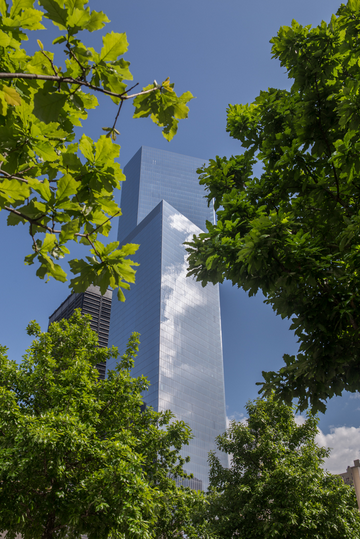Tower Power Play: Up Close and Personal with the World Trade Center Amid Roiling Debate
By Tobias Salinger June 4, 2014 1:00 pm
reprints

The springtime breeze is nice on the 57th-floor outdoor terrace of 4 World Trade Center. With a vista stretching from the Statue of Liberty to the Empire State Building and across the East River to Queens, the building will reward employees of whatever company snaps up the available 34,000-square-foot floor with a break room in the clouds.
But far down below that rarefied air, there’s intense scrutiny of a potential construction loan to complete one of the six new towers at the site. The same goes for the memorial park, the transit hub, the retail center and the performing arts center that will also one day adorn the spot where the 9/11 tragedy destroyed the twin towers and their surroundings 13 years ago.
Despite a week marked by another setback in Silverstein Properties’ quest to finance the stalled construction of one of the 3 WTC skyscraper, Chairman Larry Silverstein and other officials at the firm are inviting critics, prospective tenants and taxpayers to take a closer look at the stunning structures reaching toward the heavens from Lower Manhattan. The folks running the operation sure enjoy the view.
“It never gets old,” said Silverstein Chief Executive Officer Martin Burger. “We stare out the window like you do. Nobody appreciates what’s going on here, but when it’s open, they will.”
The 16-acre World Trade Center site, which Silverstein’s headquarters at 7 WTC abuts, will include 12.5 million square feet of office space and 440,000 square feet of retail when it’s complete. The site’s owner, the Port Authority of New York and New Jersey, estimates it will spend $4.9 billion over the next five years finishing the redevelopment, and the agency has been negotiating with Silverstein, the leaseholder, to divvy up development rights to companies like the Durst Organization (at the nearly complete 1 WTC) and Westfield Properties (for the retail space).
Executives at Silverstein like to remind naysayers skeptical of the Port’s real estate pursuits that the company has forked over $3 billion to the Port since 2001 and pays the agency around $100 million per year in rent for the 99-year ground lease Mr. Silverstein acquired six weeks before 9/11 in what was the largest real estate transaction in the city’s history at the time.
“They don’t understand that the real estate business, particularly Silverstein Properties, has been a cash cow for the Port Authority,” said Silverstein Communications Director Dara McQuillan.
Mr. McQuillan invited Commercial Observer to an exclusive three-hour grand tour that’s normally reserved for potential lessees and visiting dignitaries and took the opportunity to respond to each and every denunciation directed at the World Trade Center site. For those wondering if tenants will fill the towers, he cited new leases for 1 million square feet at the World Trade Center and adjacent Brookfield Place signed in the past month. In response to influential New York Times architecture critic Michael Kimmelman’s recent column questioning the 8-acre Sept. 11 memorial’s utility as a public space, he motioned at tourists lolling in the afternoon sun on the site atop concrete blocks the critic derided as uncomfortable and pointed out how the complex is reopening Greenwich Street to connect the Tribeca area with the rest of Lower Manhattan.
|
“Chairman Larry Silverstein and other officials at the firm are inviting critics, prospective tenants and taxpayers to take a closer look at the stunning structures reaching toward the heavens from Lower Manhattan.” |
And the rambunctious and infectious Mr. Silverstein says the planned towers will be “the best buildings ever built in America” in a promotional video the company shows to prospects in a room of dazzling renderings and models at 7 WTC. While Mr. Silverstein was unavailable for an interview, the recent scuttlebutt over construction capital for 3 WTC has not made the 83-year-old any less brash in taking his case to the public.
“The only thing I know is that I’ve been working for 13 years with the Port Authority to build the trade center, to get it finished, to get it done,” Mr. Silverstein told Crain’s New York Business in a recent video interview. “To stop now would be the dumbest thing we could possibly do, in my humble estimation. We want to get this built as fast as we possibly can, get it finished. We’ve been at it 13 years; the time is now. Let’s get the damn thing done and get on with our lives.”
But Mr. Silverstein’s entreaties have failed to sway some officials at the Port Authority who have come out against the agency guaranteeing $1.2 billion in construction loans. Port commissioners tabled their planned vote on the proposal for the third consecutive month last Wednesday, and officials there are calling on Mr. Silverstein to raise more private financing in exchange for renegotiating a 2010 agreement on the 80-story, 2.5-million-square-foot tower whose construction has stood dormant at eight floors for more than a year.
“We’ve worked very well together over a long period to get the best deal for the public,” said Commissioner Kenneth Lipper, an investment banker who has been the most vocal opponent of the proposal, at the agency’s May 28 meeting. “And the objective I’ve had from the very beginning was to make certain that the bonding capability of the Port Authority would be held intact for our mission of transportation infrastructure.”
Of course, the people at Silverstein remind everyone that transportation infrastructure is a big part of the World Trade Center, too. The transportation hub that’s beginning to take shape will be equipped for 200,000 pedestrians, 11 subway lines and PATH trains. And the connection between 3 WTC will run deeper than just that of next-door neighbors: The podium base of the building will house the mechanical equipment of the station.

The $3.94 billion winged glass and steel hub designed by Spanish architect Santiago Calatrava should fit right in with the pristine buildings at the World Trade Center conceived by three Pritzker Prize-winning architects and other famed designers.
The two standing buildings that Mr. Silverstein’s company controls—7 WTC and 4 WTC—feature vast, art-filled lobbies, elevators that read employees’ biometric cards and automatically group riders together based on their destination floors, shimmering LED light shows and walls projecting life-like images of nature over soothing music.
The smooth, terraced tower at 4 WTC is 60 percent leased, with the city’s Human Resources Administration and the Port signed on and online advertiser MediaMath in serious talks for additional space at the 72-floor, 2.5-million-square-foot structure.
The ear-popping skyscraper by Japanese master Fumihiko Maki opened in November, and while no tenants have moved in yet, it has served as the set for the Bud Light Super Bowl ad where a real-life bro finds himself in a ping-pong game with Arnold Schwarzenegger and scenes in the ill-fated remake of Annie starring Cameron Diaz and Jamie Foxx. On the day Commercial Observer visited, the artist Marcus Robinson was giving a talk on the healing power of art amid his paintings of construction workers in a temporary studio on the 48th floor.
“At first it was calm,” said building security assistant Solomon Barnes, 24, of the Bronx. “Then we had a Super Bowl commercial, and then every week, there’s something else going on.”
And there will only be more going on in coming years as the complex lurches forward. Filmmaker Mike Marcucci, who has done video work for Silverstein but produced an independent documentary on the World Trade Center called 16 Acres, predicted a bright future for the gleaming buildings despite the controversy surrounding them.
“It’s got the perfect storm of every type of stakeholder,” Mr. Marcucci said of the wrangling. “It’s a site that’s important to the world and especially this country.” But, he added, “At some point in the future, people will forget about the fighting and just admire the beautiful buildings.”


